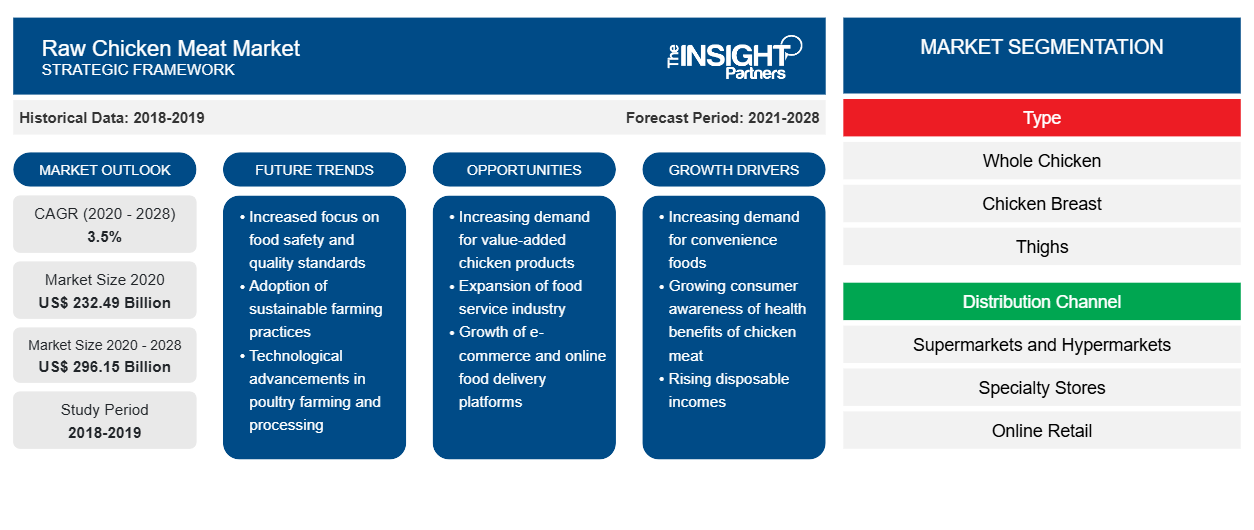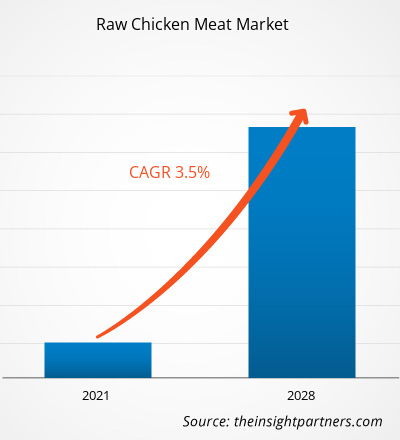The raw chicken meat market is projected to reach US$ 296,150.51 million by 2028 from US$ 232,489.41 million in 2021; it is expected to grow at a CAGR of 3.5% from 2021 to 2028.
Chicken meat is essential, as it is one of the primary protein sources for consumers in several countries. Furthermore, animal-derived food products have a protein digestibility corrected amino acid score (PDCAAS) of one or slightly below one. Chicken is easily digestible and the most budget-friendly of lean protein options; moreover, chicken protein contains all nine essential amino acids. Thus, the surging consumer inclination toward protein-rich food is the key factor propelling the raw chicken meat market growth.Asia-Pacific accounted for the largest share of the global raw chicken meat market in 2020. The market in this region is projected to register remarkable growth during the forecast period, and the projected growth is mainly attributed to rapidly increasing population, significant economic development, surge in spending capacity of people, and growth of the food & beverages industry. Asia-Pacific is one of the most lucrative markets for the manufacturers of raw chicken meat due to high demand for these products. As a result, manufacturers are offering products such as meat at affordable prices.
Customize This Report To Suit Your Requirement
You will get customization on any report - free of charge - including parts of this report, or country-level analysis, Excel Data pack, as well as avail great offers and discounts for start-ups & universities
Raw Chicken Meat Market: Strategic Insights

- Get Top Key Market Trends of this report.This FREE sample will include data analysis, ranging from market trends to estimates and forecasts.
You will get customization on any report - free of charge - including parts of this report, or country-level analysis, Excel Data pack, as well as avail great offers and discounts for start-ups & universities
Raw Chicken Meat Market: Strategic Insights

- Get Top Key Market Trends of this report.This FREE sample will include data analysis, ranging from market trends to estimates and forecasts.
Impact of COVID-19 Pandemic on Raw Chicken Meat Market
The COVID-19 pandemic hit meat production, meat prices, and supply chain in 2020. The imposition of lockdowns, reduction in the labor force, restrictions on transportation, and changes in the legislation of local and global exports introduced new challenges in the production and processing of raw chicken meat. The poultry industry that employs 1.5 million smallholder farmers observed the worst hit. According to the Frontiers Media S.A., in April 2020, meat packing facilities began to shut down owing to the accelerated spread of the SARS-CoV-2 among workers. Furthermore, according to East Asia Forum, China accounts for about 25% of the global meat consumption. However, the link of the origin of the virus disrupted the demand for animal-source food in China. Consumers have cut back on grocery bills while supply systems have been disrupted. Also, people are avoiding eating meat products at outside eateries due to the COVID-19 pandemic. However, the demand for chicken meat may grow in the coming years with a surge in average income and urban population, resulting in a steady rise in consumption over the years.
Amick Farms; Foster Farms; JBS S.A.; Koch Foods; Mountaire Farms; Perdue Farms; PILGRIM'S; Sanderson Farms; Tyson Foods, Inc.; and Wayne Farms LLC are among well-established players in the global raw chicken meat market. The market players are adopting strategies such as product developments, plant expansions, and mergers and acquisitions to expand their footprint worldwide and meet the growing demand from end users. For instance, in May 2021, Seara, a subsidiary of the JBS group, begun exporting pork and poultry protein to Cambodia and the Dominican Republic. JBS now exports protein-rich food to over 150 countries across the world.
Market Insights
Increase in Consumer Awareness About Benefits of Consuming Protein-Rich Food
With the increasing focus on health, consumers have shifted to healthy food products with a rich nutritional profile, especially protein. Proteins are the building blocks of body that maintain its structure and functions. Amino acids, the monomers in proteins, act as coenzymes or cofactors in many biochemical processes in human body. The body also uses amino acids for building and repairing muscles and bones and for making enzymes and hormones. The consumption of protein promotes proper growth and development among children and teenagers. People consuming more protein tend to maintain bone mass better and have a much lower risk of fractures and osteoporosis. Thus, the rise in consuming protein rich food is fueling the growth of the raw chicken meat market.
Type Insights
Based on type, the raw chicken meat market is segmented into whole chicken, chicken breast, thighs, drumstick, wings, and others. The chicken breast segment accounted for the largest market share in 2020 and is expected to register the highest CAGR in the market during the forecast period. The chicken breast segment is anticipated to account for the largest revenue share in the market during the forecast period. Chicken breast is a type of white meat obtained from underneath the chicken's pectoral muscle. It has low fat content and high protein content. Chicken breast is typically sold without skin and bones as most of the chicken fat is concentrated in the skin. The United States Department of Agriculture (USDA) states that the average 4-ounce serving size of raw, boneless, and skinless chicken breast contains approximately 110 calories, 26 gram of protein, 1 gram of fat, 75 milligrams of cholesterol, and 85 milligrams of sodium. The nutritional value and calorie count of a single chicken breast varies based on its size. Additionally, it is also dependent upon whether the chicken is pasture raised, free range, cage free, or caged. Chicken breast is also a good source of vitamins such as vitamin B, vitamin D, calcium, iron, and zinc. Growing preference for white meat is primarily propelling the demand for chicken breast across the globe. Moreover, chicken breast is convenient to cook at home, which adds to its popularity across the world.
Distribution Channel Insights
Based on distribution channel, the raw chicken meat market is segmented into supermarkets and hypermarkets, specialty stores, online retail, and others. The specialty stores segment accounted for the largest market share in 2020, and the supermarkets and hypermarkets segment is expected to register the highest CAGR in the market during the forecast period. Specialty stores focus on specific product category and have deep product assortments. These stores provide a personalized shopping experience and offer value-added products to their customer. Moreover, these types of stores usually have trained staff that is knowledgeable about the products they offer. Consumers prefer buying raw chicken meat through specialty retail stores to ensure the freshness and safety of the product. They may prefer ordering cooked chicken through online channels; however, they tend to visit chicken shops to purchase raw chicken meat.
A few players operating in the raw chicken meat market are include Amick Farms; Foster Farms; JBS S.A.; Koch Foods; Mountaire Farms; Perdue Farms; PILGRIM'S; Sanderson Farms; Tyson Foods, Inc.; and Wayne Farms LLC.
Raw Chicken Meat Market Regional Insights
The regional trends and factors influencing the Raw Chicken Meat Market throughout the forecast period have been thoroughly explained by the analysts at The Insight Partners. This section also discusses Raw Chicken Meat Market segments and geography across North America, Europe, Asia Pacific, Middle East and Africa, and South and Central America.
Raw Chicken Meat Market Report Scope
| Report Attribute | Details |
|---|---|
| Market size in 2020 | US$ 232.49 Billion |
| Market Size by 2028 | US$ 296.15 Billion |
| Global CAGR (2020 - 2028) | 3.5% |
| Historical Data | 2018-2019 |
| Forecast period | 2021-2028 |
| Segments Covered |
By Type
|
| Regions and Countries Covered | North America
|
| Market leaders and key company profiles |
|
Raw Chicken Meat Market Players Density: Understanding Its Impact on Business Dynamics
The Raw Chicken Meat Market is growing rapidly, driven by increasing end-user demand due to factors such as evolving consumer preferences, technological advancements, and greater awareness of the product's benefits. As demand rises, businesses are expanding their offerings, innovating to meet consumer needs, and capitalizing on emerging trends, which further fuels market growth.

- Get the Raw Chicken Meat Market top key players overview
Report Spotlights
- Progressive industry trends in the raw chicken meat market to help players develop effective long-term strategies
- Business growth strategies adopted by the market players to secure growth in developed and developing markets
- Quantitative analysis of the raw chicken meat market from 2019 to 2028
- Estimation of global demand for raw chicken meat
- Porter’s Five Forces analysis to illustrate the efficacy of buyers and suppliers operating in the industry
- Recent developments to understand the competitive market scenario
- Market trends and outlook as well as factors driving and restraining the growth of the raw chicken meat market
- Assistance in decision-making process by highlighting market strategies that underpin commercial interest, leading to the market growth
- Detailed overview and segmentation of the market, as well as the raw chicken meat industry dynamics
- Size of the raw chicken meat market in various regions with promising growth opportunities
Raw Chicken Meat Market – by Type
- Whole Chicken
- Chicken Breast
- Thighs
- Drumstick
- Wings
- Others
Raw Chicken Meat Market – by Distribution Channel
- Supermarkets and Hypermarkets
- Specialty Stores
- Online Retail
- Others
Company Profiles
- Amick Farms
- Foster Farms
- JBS S.A.
- Koch Foods
- Mountaire Farms
- Perdue Farms
- PILGRIM'S
- Sanderson Farms
- Tyson Foods, Inc.
- Wayne Farms LLC
Frequently Asked Questions
How is the competitive rivalry in the global raw chicken meat market?
Which major factors are influencing the growth of global raw chicken meat market?
Based on type, which segment is leading the global raw chicken meat market during the forecast period?
Which region held the largest share of the global raw chicken meat market?
Can you list some of the major players operating in the global raw chicken meat market?
Based on distribution channel, which segment led the global raw chicken meat market in 2020?
- Historical Analysis (2 Years), Base Year, Forecast (7 Years) with CAGR
- PEST and SWOT Analysis
- Market Size Value / Volume - Global, Regional, Country
- Industry and Competitive Landscape
- Excel Dataset
Recent Reports
Related Reports
Testimonials
Reason to Buy
- Informed Decision-Making
- Understanding Market Dynamics
- Competitive Analysis
- Identifying Emerging Markets
- Customer Insights
- Market Forecasts
- Risk Mitigation
- Boosting Operational Efficiency
- Strategic Planning
- Investment Justification
- Tracking Industry Innovations
- Aligning with Regulatory Trends





















 Get Free Sample For
Get Free Sample For